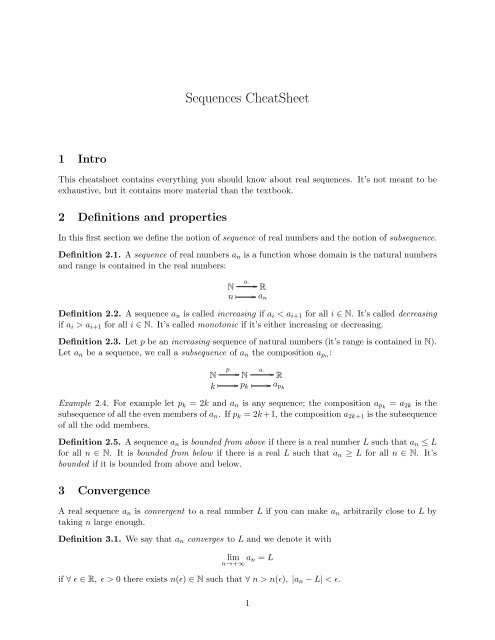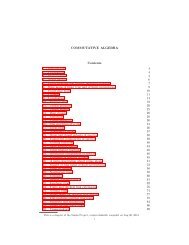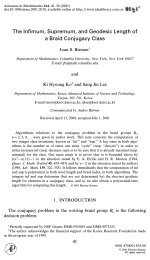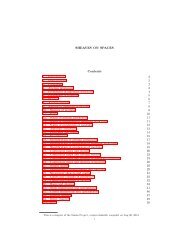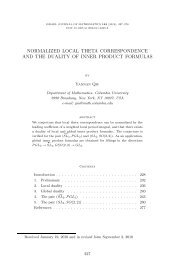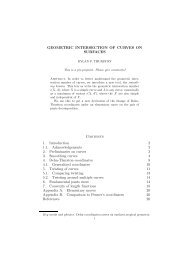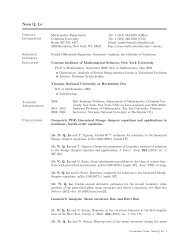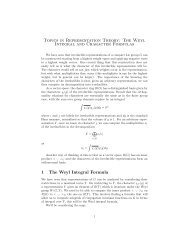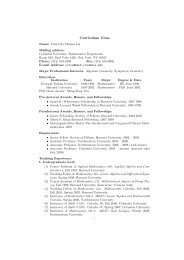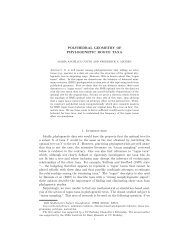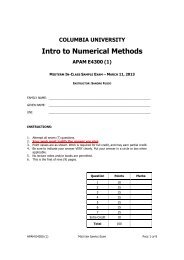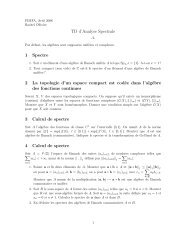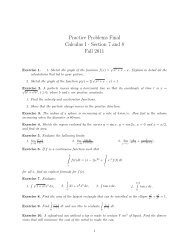Sequences CheatSheet
Sequences CheatSheet
Sequences CheatSheet
Create successful ePaper yourself
Turn your PDF publications into a flip-book with our unique Google optimized e-Paper software.
1 Intro<br />
<strong>Sequences</strong> <strong>CheatSheet</strong><br />
This cheatsheet contains everything you should know about real sequences. It’s not meant to be<br />
exhaustive, but it contains more material than the textbook.<br />
2 Definitions and properties<br />
In this first section we define the notion of sequence of real numbers and the notion of subsequence.<br />
Definition 2.1. A sequence of real numbers an is a function whose domain is the natural numbers<br />
and range is contained in the real numbers:<br />
N a· <br />
R<br />
n <br />
an<br />
Definition 2.2. A sequence an is called increasing if ai < ai+1 for all i ∈ N. It’s called decreasing<br />
if ai > ai+1 for all i ∈ N. It’s called monotonic if it’s either increasing or decreasing.<br />
Definition 2.3. Let p be an increasing sequence of natural numbers (it’s range is contained in N).<br />
Let an be a sequence, we call a subsequence of an the composition apn:<br />
N p· a· <br />
N <br />
R<br />
k <br />
pk <br />
Example 2.4. For example let pk = 2k and an is any sequence; the composition apk = a2k is the<br />
subsequence of all the even members of an. If pk = 2k+1, the composition a2k+1 is the subsequence<br />
of all the odd members.<br />
Definition 2.5. A sequence an is bounded from above if there is a real number L such that an ≤ L<br />
for all n ∈ N. It is bounded from below if there is a real L such that an ≥ L for all n ∈ N. It’s<br />
bounded if it is bounded from above and below.<br />
3 Convergence<br />
A real sequence an is convergent to a real number L if you can make an arbitrarily close to L by<br />
taking n large enough.<br />
apk<br />
Definition 3.1. We say that an converges to L and we denote it with<br />
lim<br />
n→+∞ an = L<br />
if ∀ ɛ ∈ R, ɛ > 0 there exists n(ɛ) ∈ N such that ∀ n > n(ɛ), |an − L| < ɛ.<br />
1
is.<br />
In this definition ɛ measures how close we are to L and n(ɛ) tells us how large “large enough”<br />
Example 3.2. Let an be the sequence 1<br />
np where p is a positive real number. Pick any number ɛ > 0.<br />
The condition:<br />
1<br />
< ɛ<br />
np is fulfilled if:<br />
1<br />
−<br />
n > ɛ p<br />
1<br />
−<br />
The number ɛ p is positive but not natural, so we put<br />
1<br />
−<br />
n(ɛ) = ɛ p<br />
This choice of n(ɛ) proves that an converges to zero. The writing ⌈x⌉ denotes the ceiling function<br />
which maps x to the smallest integer which is greater than or equal to x.<br />
A real sequence an is divergent if you can make an arbitrarily large (positive or negative) by<br />
taking n large enough.<br />
Definition 3.3. We say that an is divergent and denote it with:<br />
lim<br />
n→+∞ an = +∞<br />
if ∀C ∈ R there exists n(C) ∈ N such that ∀ n > n(C), an > C.<br />
Example 3.4. Let an be the sequence ln (n). Let C be any positive real number. The condition<br />
ln (n) > C is satisfied if we pick n > e C because the exponential is an increasing function. We<br />
prove that an is divergent by choosing n(C) = e C .<br />
A sequence might be neither convergent nor divergent; for example an = (−1) n is certainly not<br />
divergent but it doesn’t converge to any number either. In the next section we shall see a method<br />
to prove that a sequence is not convergent.<br />
4 Techniques<br />
Sometimes a sequence can be a real function in disguise. In that case the limit of the sequence is<br />
the limit of the function, if this limit does exist.<br />
Proposition 4.1. Let f(x) be a function of one real variable whose domain contains the interval<br />
[1, +∞). Let an be the sequence f(n) where n is any natural number. If:<br />
lim f(x) = L<br />
x→+∞<br />
where L is a real number or also ±∞, then the sequence an has the same limit:<br />
lim<br />
n→+∞ an = L<br />
If the function f(x) doesn’t have a limit we cannot conclude anything about the sequence: it<br />
might or might not converge. Consider for instance an = sin (πn). The function f(x) = sin (πx)<br />
doesn’t have a limit but an = sin(πn) = 0 for all natural numbers n, so an converges to zero.<br />
There are sequences that do not come from a function of one real variable or they come from<br />
some non elementary function. For instance p n does not come from a real function if p is negative.<br />
The sequence n! comes from a real function, the Gamma function, but unfortunately this function<br />
is not an elementary one. In all these cases we might need some specific technique to study the<br />
convergence.<br />
2
Proposition 4.2. A sequence an converges to L ∈ R if and only if every subsequence converges to<br />
L.<br />
Example 4.3. The sequence an = (−1) n is not convergent. The subsequence a2n converges to<br />
1 and the subsequence a2n+1 converges to −1. If an were convergent to some number L all its<br />
subsequences should converge to the same L, so an is not convergent.<br />
If two subsequences converge to the same limit, in general we cannot conclude that the sequence<br />
is convergent. However the subsequence of even members and the subsequence of odd members are<br />
special: if they are both convergent and they converge to the same limit, then the original sequence<br />
is convergent as well:<br />
Proposition 4.4. Let an be a real sequence. If the subsequence a2n converges to a real number L<br />
and the subsequence a2n+1 converges to the same number L, then an converges to L as well.<br />
Proof. Choose a positive ɛ ∈ R. Since a2n converges to L, there is p(ɛ) such that ∀n > p(ɛ), |a2n −<br />
L| < ɛ. There is also q(ɛ) such that ∀n > q(ɛ), |a2n+1 −L| < ɛ. Set n(ɛ) equal to max(2p(ɛ), 2q(ɛ)+<br />
1). For all n > n(ɛ) we are either in the odd or the even case so |an − L| < ɛ, which proves the<br />
convergence of an to L.<br />
This proposition can be used even when the two subsequences go to infinity.<br />
With the following two propositions we can compare sequences both when they are convergent<br />
and divergent.<br />
Proposition 4.5 (Squeeze theorem). Let an, bn, cn be three sequences of real numbers. If there is<br />
n0 ∈ N such that ∀n ≥ n0, an ≤ bn ≤ cn and both an and cn converge to L ∈ R then also bn<br />
converges to L.<br />
Proof. According to the definition of limit for every ɛ > 0 there exists nɛ such that for every n ≥ nɛ:<br />
and there exists mɛ such that if n ≥ mɛ:<br />
L − ɛ < an < L + ɛ<br />
L − ɛ < cn < L + ɛ<br />
If we now choose p = max nɛ, mɛ, n0 all the inequalities are true simultaneously for every n ≥ p<br />
and we can deduce:<br />
L − ɛ < an ≤ bn ≤ cn < L + ɛ<br />
which proves that bn converges to L.<br />
Proposition 4.6. Let an, bn be two sequences. If there is n0 ∈ N such that ∀n ≥ n0, an ≤ bn and<br />
limn→+∞ an = +∞ then also limn→∞ bn = +∞.<br />
Not as popular as the root ratio test for series, but even sequences have a root and ratio test<br />
that can be helpful in certain calculations:<br />
Proposition 4.7. Let an be a sequence of real numbers such that n |an| converges to L. If L < 1<br />
the sequence converges to zero, if L > 1 the sequence is divergent, if L = 1 the test is inconclusive.<br />
<br />
<br />
Proposition 4.8. Let an be a sequence of real numbers such that an+1<br />
<br />
<br />
converges to L. If L < 1<br />
an<br />
the sequence converges to zero, if L > 1 the sequence is divergent, if L = 1 the test is inconclusive.<br />
3
The two tests are perfectly equivalent; if one is inconclusive the other one is also inconclusive.<br />
You can choose the most convenient one in a specific calculation. For example: determine for which<br />
real numbers a the following sequence is convergent:<br />
an = n!an<br />
n n<br />
When dealing with a factorial, the ratio test is always the best bet:<br />
an+1<br />
an<br />
=<br />
(n + 1)a<br />
(n + 1)(1 + 1<br />
n )n<br />
The limit of the sequence is a<br />
e . If a > e the sequence diverges, if a < e the sequence converges to<br />
zero. If a = e the test is inconclusive. It can be shown by finer techniques that the case a = e is<br />
actually divergent.<br />
proof of prop. 4.7. If L < 1 we can choose ɛ > 0 such that L + ɛ < 1. According to the definition<br />
of limit there exists nɛ ∈ N such that if n ≥ nɛ we have:<br />
or equivalently:<br />
L − ɛ < n |an| < L + ɛ < 1<br />
0 ≤ |an| < (L + ɛ) n<br />
Since L + ɛ < 1 the sequence (L + ɛ) n converges to zero and according to the squeeze theorem |an|<br />
converges to zero as well. If the absolute value converges to zero, even an converges to zero.<br />
If L > 1 we can choose ɛ > 0 such that L − ɛ > 1. If n ≥ nɛ we have:<br />
(L − ɛ) n ≤ |an|<br />
and since (L − ɛ) n diverges to +∞, the sequences |an| and an are also divergent.<br />
proof of prop. 4.8. If L < 1 we can choose ɛ > 0 such that L + ɛ < 1. According to the definition<br />
of limit there exists nɛ ∈ N such that if n ≥ nɛ we have:<br />
<br />
<br />
< L + ɛ < 1<br />
an+1<br />
an<br />
If n ≥ Nɛ we can apply the inequality repeatedly and obtain:<br />
|an| ≤ (L + ɛ) n−nɛ anɛ<br />
0 ≤ |an| < (L + ɛ) n<br />
Since L + ɛ < 1 the sequence (L + ɛ) n−nɛ converges to zero and according to the squeeze theorem<br />
|an| converges to zero as well. If the absolute value converges to zero, even an converges to zero.<br />
If L > 1 we can choose ɛ > 0 such that L − ɛ > 1. If n ≥ nɛ we have:<br />
<br />
<br />
(L − ɛ) ≤ <br />
Applying repeatedly we get:<br />
an+1<br />
an<br />
(L − ɛ) n−nɛ anɛ ≤ |an|<br />
and since (L − ɛ) n−nɛ− diverges to +∞, the sequences |an| and an are also divergent.<br />
4
The following proposition can be helpful when nothing else works.<br />
Proposition 4.9. A real sequence an which is bounded from above and increasing is convergent.<br />
A sequence which is bounded from below and decreasing is convergent.<br />
This statement is a consequence of the least upper bound property of the real numbers. We<br />
introduce here some notation and definitions and we will need to explain this property.<br />
Without entering into formal details, we say that a set X is ordered if the symbol ≤ is defined<br />
on it, and for any two elements x, y ∈ X we can always say whether x ≤ y or y ≤ x.<br />
Definition 4.10. A subset A of an ordered set X is bounded from above if there exists x ∈ X<br />
such that x ≥ a for every a ∈ A. We call x an upper bound of A.<br />
A subset A of an ordered set X is bounded from below if there exists x ∈ X such that x ≤ a<br />
for every a ∈ A. We call x a lower bound of A.<br />
Definition 4.11. The supremum of a bounded from above set A, is the smallest upper bound of<br />
A (it might not exist!). We denote it with sup(A). The infimum of a bounded from below set A,<br />
is the greatest upper bound of A (it might not exist!). We denote it with inf(A).<br />
If α is the supremum of A we can express that it is the smallest upper bound in the following<br />
way:<br />
1. α ≥ a for every a ∈ A<br />
2. For every positive number ɛ, the number α−ɛ is not an upper bound, which means that there<br />
exists aɛ ∈ A such that aɛ > α − ɛ.<br />
Definition 4.12. An ordered set X has the least upper bound property if for every subset A ⊂ X<br />
which is bounded from above, there exists α ∈ X which is the supremum of A.<br />
Theorem 4.13. The real numbers have the least upper bound property.<br />
The proof of this theorem is not obvious and it’s founded on the rigorous definition of the real<br />
numbers that we have accurately omitted.<br />
Remark 4.14. The rational numbers for instance don’t have the least upper bound property. The<br />
set A = {p ∈ Q p 2 < 2} ⊂ Q is clearly bounded from above but it doesn’t have a smallest upper<br />
bound. Such a number would be √ 2 which is not rational.<br />
Remark 4.15. If a set has the least upper bound property then it’s also true that every bounded<br />
from below subset has an infimum.<br />
proof of proposition 4.9. Denote with R the range of the sequence an. Since the sequence is bounded<br />
from above, the set R is also bounded from above. Since the real numbers have the least upper<br />
bound property there is L ∈ R which is the supremum of R. For every ɛ > 0, the number L − ɛ is<br />
not a supremum so there exists nɛ ∈ N such that L − ɛ < anɛ. Since the sequence is increasing, for<br />
every n ≥ nɛ we have:<br />
L − ɛ < anɛ ≤ an < L + ɛ<br />
which proves that L is actually the limit of the sequence.<br />
The proof in the decresing bounded from below case, is exactly the same.<br />
5
5 Induction<br />
Mathematical induction is not a technique specifically meant to study the convergence of a sequence,<br />
nonetheless it can be very helpful in this kind of scenario. We denote with Pn a statement involving<br />
a natural number n. For a given number n the statement can be true or false.<br />
Proposition 5.1. Let P = {Pn; n ∈ N} be a set of statements involving a natural number n.<br />
Suppose that the following conditions are satisfied:<br />
1. the statement P1 is true;<br />
2. Pn is true implies that Pn+1 is true as well;<br />
then the statement Pn is true for every natural number n.<br />
We can replace the first condition with: Pn0 is true; in this case the proposition changes to: the<br />
statement Pn is true for every n ≥ n0.<br />
Example 5.2. We can prove by induction that:<br />
is true for all natural numbers.<br />
Pn :<br />
1. If n = 1 the statement is trivially true.<br />
2. Suppose that Pn is true.<br />
n+1 <br />
i =<br />
i=1<br />
n<br />
i + (n + 1) =<br />
i=1<br />
This proves that:<br />
is true.<br />
n<br />
i =<br />
i=1<br />
n(n + 1)<br />
2<br />
Pn+1 :<br />
n(n + 1)<br />
2<br />
+ (n + 1) = n2 + 2n + 3<br />
2<br />
n+1 <br />
i =<br />
i=1<br />
(n + 1)(n + 2)<br />
2<br />
According to the proposition, the statement Pn is true for every natural number.<br />
6 Fundamental limits of sequences<br />
= (n + 1)(n + 2)<br />
2<br />
The following limits should be considered fundamental, and you don’t have to retrieve them each<br />
time you do a calculation:<br />
•<br />
lim<br />
n→+∞ np =<br />
⎧<br />
⎪⎨<br />
⎪⎩<br />
6<br />
+∞ if p > 0<br />
1 if p = 0<br />
0 if p < 0
•<br />
•<br />
•<br />
•<br />
•<br />
•<br />
•<br />
lim<br />
n→+∞ pn =<br />
⎧<br />
⎪⎨<br />
⎪⎩<br />
lim<br />
n→+∞<br />
0 if −1 < p < 1<br />
1 if p = 1<br />
+∞ if p > 1<br />
does not exist if p ≤ −1<br />
n√ n = 1<br />
<br />
lim 1 +<br />
n→+∞<br />
1<br />
n<br />
lim<br />
n→+∞<br />
n<br />
n!<br />
lim = 0<br />
n→+∞ nn e<br />
lim<br />
n→+∞<br />
n<br />
n!<br />
lim<br />
n→+∞<br />
= 0<br />
np = 0<br />
en = e<br />
ln(n)<br />
= 0 if p > 0<br />
np The number p in all the previous formulas is a real number. The last four limits compare how<br />
fast the functions (n n , n!, e n , n p , ln(n)) go to infinity. The result can be read as: n n is the fastest,<br />
followed by the factorial, followed by the exponential, followed by any power function; and the<br />
logarithm is the slowest.<br />
7 Examples of recursive sequences<br />
A sequence can be defined recursively; this means that we choose the first element in the sequence<br />
and we define any other element as a function of its predecessor:<br />
<br />
a1 = c<br />
an+1 = f(an)<br />
where f(·) is a function of one real variable. Sometimes it’s possible to make a recursive sequence<br />
explicit, but it’s usually harder to find the explicit sequence than studying the convergence directly.<br />
Example 7.1. Consider the following recursive sequence:<br />
<br />
a1 = 1<br />
an+1 = √ 1 + an<br />
The n-th term of the sequence looks like this:<br />
<br />
<br />
an = 1 + 1 + √ 1 + . . .<br />
<br />
n+1 times<br />
7
First of all we notice that this sequence is increasing. We can prove it by induction:<br />
a1 = 1 < a2 = √ 2<br />
Assume that an ≤ an+1 and try to prove that an+1 ≤ an+2:<br />
This implies that:<br />
an = a 2 n+1 − 1 ≤ an+1 = a 2 n+2 − 1<br />
a 2 n+1 ≤ a 2 n+2<br />
and this is satisfied if −an+2 ≤ an+1 ≤ an+2. Now we prove by induction that the sequence is<br />
bounded above by 3. The first element is less then 3. Suppose that an ≤ 3. This implies:<br />
an+1 = √ 1 + an ≤ √ 4 < 3<br />
According to proposition 4.9 the sequence is convergent. Since the sequence is convergent every<br />
subsequence must converge to the same limit, in particular an+1 has the same limit as an:<br />
√<br />
1 + an = √ 1 + L<br />
L = lim<br />
n→+∞ an+1 = lim<br />
n→+∞<br />
This is satisfied if L = √ 1 + L, and since L must be positive L = 1+√5 2<br />
of 1.<br />
Example 7.2. Consider the degree 2 equation<br />
which is the golden ratio<br />
x 2 − bx − c = 0 (1)<br />
where b, c are integers and for simplicity we assume that they are strictly positive. Since x = 0 is<br />
not a solution we can divide everything by x and obtain the following:<br />
x = b + c<br />
x<br />
This equation expresses x as a “function of itself”; we can take this function and plug it into the<br />
right hand side:<br />
x = b + c<br />
b + c<br />
x<br />
and we can repeat this same procedure indefinitely:<br />
c<br />
x = b +<br />
c<br />
b + c<br />
b +<br />
b +<br />
c<br />
b + . . .<br />
This representation of the solution of the degree two equation is known as continued fraction and<br />
can be written as a recursive sequence:<br />
<br />
a1 = c<br />
an+1 = c<br />
b+an<br />
We can prove that this sequence is convergent and it converges to the solution of the equation minus<br />
b (with this kind of representation we are missing the first b in the continued fraction). It’s easy to<br />
8
prove that the sequence is bounded from above by c and from below by c , but the sequence is<br />
b+c<br />
quite clearly not monotonic (just calculate the first three members). At a closer look the sequence<br />
turns out to be oscillating: the subsequence of the even members is increasing, and the subsequence<br />
of the odd members is decreasing (this is left as an exercise to the reader). Since a2n and a2n+1<br />
are bounded and monotonic they are both convergent. A priori they might converge to different<br />
limits! We can explicitly calculate these limits as in the previous example:<br />
and taking the limit of both the two members:<br />
c<br />
a2n+2 = c<br />
b +<br />
b + a2n<br />
L = lim<br />
n→+∞ a2n+2 =<br />
c<br />
b + c<br />
b + L<br />
This implies that the limit L satisfies the following equation:<br />
L 2 + bL − c = 0<br />
The positive solution of this equation is precisely the solution of (1) minus b. With the same method<br />
we can prove that the limit of the odd members satisfy the same equation. Since the subsequences<br />
of even and odd members converge to the same limit L, according to proposition 4.4 we deduce<br />
that an converges to L.<br />
In the special case b = c = 1, the solution to (1) is:<br />
1<br />
x = 1 +<br />
1<br />
1 +<br />
1<br />
1 +<br />
1 +<br />
1<br />
1 + . . .<br />
and this is another representation of the golden ratio.<br />
8 Stolz-Cesàro<br />
This last section is devoted to a technique, known as Stolz-Cesàro theorem, which is somehow the<br />
equivalent of l’Hôpital for sequences.<br />
Theorem 8.1 (Stolz-Cesàro). Let an be a sequence of real numbers and bn an increasing sequence<br />
such that limn→+∞ bn = +∞. If the limit:<br />
then the sequence an<br />
bn<br />
is also convergent to L:<br />
The number L can also be ±∞.<br />
an+1 − an<br />
lim<br />
n→+∞ bn+1 − bn<br />
an<br />
lim<br />
n→+∞ bn<br />
9<br />
= L<br />
= L
Proof. By definition of limit, for every ɛ > 0 there exists nɛ ∈ N such that for every n ≥ nɛ we<br />
have:<br />
L − ɛ < an+1 − an<br />
bn+1 − bn<br />
< L + ɛ<br />
Since bn is increasing the number bn+1 − bn is always positive so we can multiply the inequality:<br />
(L − ɛ)(bn+1 − bn) < an+1 − an < (L + ɛ)(bn+1 − bn)<br />
If k ≥ nɛ, we can sum the three members of the inequality from nɛ up to k. Since the inequalities<br />
hold for each one of the summands, they also hold for the summation:<br />
(L − ɛ)<br />
k<br />
(bn+1 − bn) <<br />
n=nɛ<br />
k<br />
(an+1 − an) < (L + ɛ)<br />
n=nɛ<br />
k<br />
((bn+1 − bn))<br />
In each one of these summations, only the first and the last element don’t cancel out, so we get:<br />
n=nɛ<br />
(L − ɛ)(bk+1 − bnɛ) < ak+1 − anɛ < (L + ɛ)(bk+1 − bnɛ)<br />
If k is large enough we can assume that bk+1 is positive, since limk→+∞ bk = +∞, so we can divide<br />
everything by bk+1:<br />
<br />
(L − ɛ) 1 − bnɛ<br />
<br />
+<br />
bk+1<br />
anɛ<br />
bk+1<br />
< ak+1<br />
bk+1<br />
<br />
< (L + ɛ) 1 − bnɛ<br />
<br />
+<br />
bk+1<br />
anɛ<br />
bk+1<br />
The number nɛ is fixed, and bk+1 goes to +∞ when k is large; for this reason both anɛ<br />
converge to zero. We can find kɛ ∈ N such that for all k ≥ kɛ we have:<br />
and also:<br />
Using these last two inequalities we get:<br />
which proves that:<br />
Example 8.2. Calculate the limit:<br />
−ɛ < anɛ<br />
− (L + ɛ)<br />
bk+1<br />
bnɛ<br />
bk+1<br />
−ɛ < anɛ<br />
− (L − ɛ)<br />
bk+1<br />
bnɛ<br />
bk+1<br />
L − 2ɛ < ak+1<br />
bk+1<br />
ak+1<br />
lim<br />
k→+∞ bk+1<br />
< L + 2ɛ<br />
= L<br />
1<br />
lim<br />
n→+∞<br />
k + 2k + . . . + nk nk+1 According to Stolz-Cesàro the limit is equal to the following:<br />
lim<br />
n→+∞<br />
(n + 1) k<br />
(n + 1) k+1 = lim<br />
− nk+1 n→+∞<br />
k+1<br />
i=0<br />
< ɛ<br />
< ɛ<br />
(n + 1) k<br />
<br />
ni − nk+1 k+1<br />
i<br />
10<br />
= lim<br />
n→+∞<br />
bk+1<br />
(n + 1) k<br />
<br />
ni =<br />
k<br />
i=0<br />
k+1<br />
i<br />
and bnɛ<br />
bk+1
= lim<br />
n→+∞<br />
(1 + n −1 ) k<br />
k<br />
i=0<br />
k+1<br />
i<br />
n i−k<br />
= 1<br />
k+1<br />
k<br />
= 1<br />
k + 1<br />
If k ≤ −1 the denominator is not an increasing sequence so the method cannot be applied. We<br />
will prove later on with some other technique that for k = −1 we have:<br />
Example 8.3. Calculate the limit:<br />
lim<br />
n→+∞ 1−1 + 2 −1 + . . . n −1 = +∞<br />
lim<br />
n→+∞<br />
n k=1 1<br />
k − log n<br />
log n<br />
According to Stolz-Cesàro the limit is equal to the following:<br />
<br />
1<br />
1<br />
n+1 − log (n + 1) + log n<br />
n+1 − log 1 +<br />
lim<br />
= lim<br />
n→+∞ log (n + 1) − log n n→+∞<br />
1<br />
<br />
n<br />
= lim<br />
n→+∞<br />
log<br />
1 + 1<br />
n<br />
1<br />
1+ 1<br />
n<br />
<br />
− n log 1 + 1<br />
<br />
n log<br />
1 + 1<br />
n<br />
n<br />
<br />
= 0<br />
We don’t know if the numerator is convergent or not, but this calculation shows that it cannot<br />
diverge faster than log n. It also shows that n k=1 1<br />
k goes to infinity as fast as log n.<br />
11


